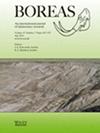Holocene mountain landscape development and monsoon variation in the southernmost Russian Far East
IF 2.4
3区 地球科学
Q2 GEOGRAPHY, PHYSICAL
引用次数: 7
Abstract
A c. 9720‐year history of a mountain lake–mire complex on the Shufan Plateau (southern Primorye, Russian Far East) is based on a multi‐proxy study of peat deposits. The chronology is based on eight radiocarbon dates in addition to two dated tephra horizons. The sediment contains eight cryptotephra layers attributable to Baitoushan, a volcano on the Korea/China border. Pollen, diatom and botanical macrofossil analyses indicate climate fluctuations during the Holocene and a compositional response of biodiverse mountain forests to changes in temperature and humidity. Widespread, diverse broadleaf‐dominated forest marked a warm Early Holocene (~9500–9280 cal. a BP). Korean pine (Pinus koraiensis) rose to dominance in the Middle Holocene (after c. 7630 cal. a BP). Evergreen conifers, fir (Abies) in particular, became widespread after 2.9 ka BP and show a positive response to the Little Ice Age cooling. Over the c. 10 000‐year record, moisture appears largely controlled by gradually declining intensity of the summer monsoon, trending from moist conditions in the Early Holocene to cooler and drier conditions in the Late Holocene with shorter‐term hydrological changes superimposed. Peat composition indicates significant changes in mire vegetation, and diatom assemblages indicate four stages of inundation and three dry stages in the basin, probably controlled by precipitation changes. The initial importance of atmospheric precipitation shifted over time to a greater input from groundwater. During a long episode in the Late Holocene the basin may have dried out. Forest fires occurred during much of the Middle and Late Holocene, and their prominence, as marked by macro‐charcoal, is related to changes in humidity. Human activities mark the past few centuries. Medieval fires were probably anthropogenic, and there is evidence of agricultural impact on the landscape during the Jin Empire settlement period 900–700 years ago and of more recent forest exploitation, particularly a reduction in conifer taxa.俄罗斯远东最南端全新世山地景观发展与季风变化
舒凡高原(俄罗斯远东普里莫耶南部)一个约9720年的山地湖泊-沼泽复合体的历史是基于对泥炭矿床的多代理研究。该年表基于八个放射性碳年代以及两个年代确定的火山灰层。沉积物中有八层隐火山灰层,可归属于韩中边境的白头山火山。花粉、硅藻和植物宏化石分析表明,全新世的气候波动以及生物多样性山林的成分对温度和湿度变化的反应。广泛多样的阔叶林标志着温暖的全新世早期(~9500–9280 cal.a BP)。朝鲜松(Pinus koraiensis)在全新世中期(公元7630年)上升到优势地位。常绿针叶树,尤其是冷杉,在2.9 ka BP之后变得广泛分布,并对小冰河时期的降温表现出积极的反应。在约10000年的记录中,湿度似乎在很大程度上受到夏季风强度逐渐下降的控制,从全新世早期的潮湿条件到全新世晚期的凉爽和干燥条件,叠加了短期水文变化。泥炭成分表明沼泽植被发生了显著变化,硅藻组合表明盆地处于四个淹没阶段和三个干旱阶段,可能受降水变化的控制。大气降水最初的重要性随着时间的推移而转移到地下水的更大投入。在全新世晚期的一段长时期内,盆地可能已经干涸。森林火灾发生在全新世中期和晚期的大部分时间,其突出程度(以宏观木炭为标志)与湿度变化有关。人类活动标志着过去几个世纪。中世纪的火灾可能是人为的,有证据表明,在900-700年前的金帝国定居期间,农业对景观产生了影响,最近的森林开发,尤其是针叶树类群的减少。
本文章由计算机程序翻译,如有差异,请以英文原文为准。
求助全文
约1分钟内获得全文
求助全文
来源期刊

Boreas
地学-地球科学综合
CiteScore
5.90
自引率
4.50%
发文量
36
审稿时长
>12 weeks
期刊介绍:
Boreas has been published since 1972. Articles of wide international interest from all branches of Quaternary research are published. Biological as well as non-biological aspects of the Quaternary environment, in both glaciated and non-glaciated areas, are dealt with: Climate, shore displacement, glacial features, landforms, sediments, organisms and their habitat, and stratigraphical and chronological relationships.
Anticipated international interest, at least within a continent or a considerable part of it, is a main criterion for the acceptance of papers. Besides articles, short items like discussion contributions and book reviews are published.
 求助内容:
求助内容: 应助结果提醒方式:
应助结果提醒方式:


